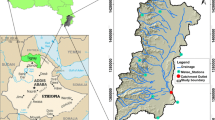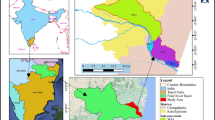Abstract
Distributed modeling provides for mapping of spatial and temporal patterns of highly stressed regions, and it offers local solutions to reduce stress in aquifers. In this study, the groundwater stress index (GWSI) is evaluated based on the groundwater footprint index over the Varamin aquifer in Iran. Using ArcGIS software, all necessary layers were produced and then input into the Groundwater Modeling System software to evaluate GWSI. The results show that distributed modeling offers a more accurate assessment of GWSI than water budget analysis. The minimum and maximum values of the GWSI calculated by the distributed model are 2.4 and 1.4 times, respectively, higher than those values obtained in previous studies. Besides, a significant agreement was observed between highly stressed areas and agricultural land use. Furthermore, the results obtained from comparison between stress pattern and land subsidence indicated that only 10% of the area under subsidence was caused by groundwater stress. Applying appropriate scenarios in the future can be useful to reduce water stress and its increasing trend.











Similar content being viewed by others
References
Al-Naeem, A. A. (2014). Effect of excess pumping on groundwater salinity and water level in Hail region of Saudi Arabia. Research Journal of Environmental Toxicology, 8(3), 124.
Atarzadeh, A. A., Tavana, B., & Abrazi, B. (2014). Quantitative and contamination studies of Varamin aquifer (groundwater studies). Tehran: Yekom Consulting Engineering.
Banerji, S., Biswas, M., & Mitra, D. (2020). Semi-quantitative analysis of land use homogeneity and spatial distribution of individual ecological footprint in selected areas of Eastern fringes of Kolkata, West Bengal. Geocarto International, 35(1), 78–92.
Bredehoeft, J. D. (2002). The water budget myth revisited: Why hydrogeologists model. Groundwater, 40(4), 340–345.
Das, S. (2019). Comparison among influencing factor, frequency ratio, and analytical hierarchy process techniques for groundwater potential zonation in Vaitarna basin, Maharashtra, India. Groundwater for Sustainable Development, 8, 617–629.
Das, S., Gupta, A., & Ghosh, S. (2017). Exploring groundwater potential zones using MIF technique in semi-arid region: A case study of Hingoli district, Maharashtra. Spatial Information Research, 25(6), 749–756.
Das, S., & Pardeshi, S. D. (2018). Integration of different influencing factors in GIS to delineate groundwater potential areas using IF and FR techniques: A study of Pravara basin, Maharashtra, India. Applied Water Science, 8(7), 197.
Das, S., Pardeshi, S. D., Kulkarni, P. P., & Doke, A. (2018). Extraction of lineaments from different azimuth angles using geospatial techniques: A case study of Pravara basin, Maharashtra, India. Arabian Journal of Geosciences, 11(8), 160.
Dumont, A., Salmoral, G., & Llamas, M. R. (2013). The water footprint of a river basin with a special focus on groundwater: The case of Guadalquivir basin (Spain). Water Resources and Industry, 1, 60–76.
Esnault, L., Gleeson, T., Wada, Y., Heinke, J., Gerten, D., Flanary, E., et al. (2014). Linking groundwater use and stress to specific crops using the groundwater footprint in the Central Valley and High Plains aquifer systems, US. Water Resources Research, 50(6), 4953–4973.
Galloway, D. L., Hudnut, K. W., Ingebritsen, S. E., Phillips, S. P., Peltzer, G., Rogez, F., et al. (1998). Detection of aquifer system compaction and land subsidence using interferometric synthetic aperture radar, Antelope Valley, Mojave Desert, California. Water Resources Research, 34(10), 2573–2585.
Gambolati, G., & Teatini, P. (2015). Geomechanics of subsurface water withdrawal and injection. Water Resources Research, 51(6), 3922–3955.
Goode, D. J. (2016). Map visualization of groundwater withdrawals at the sub-basin scale. Hydrogeology Journal, 24(4), 1057–1065.
Gleeson, T., & Wada, Y. (2013). Assessing regional groundwater stress for nations using multiple data sources with the groundwater footprint. Environmental Research Letters, 8(4), 044010.
Gleeson, T., Wada, Y., Bierkens, M. F., & Van Beek, L. P. (2012). Water balance of global aquifers revealed by groundwater footprint. Nature, 488(7410), 197–200.
Gorgij, A. D., Kisi, O., Moayeri, M. M., & Moghaddam, A. A. (2018). Hydraulic conductivity estimation via the AI-based numerical model optimization using the harmony search algorithm. Hydrology Research, 49(5), 1669–1683.
Guzy, A., & Malinowska, A. A. (2020). State of the art and recent advancements in the modelling of land subsidence induced by groundwater withdrawal. Water, 12(7), 2051.
Jafari, F., Javadi, S., Golmohammadi, G., Karimi, N., & Mohammadi, K. (2016). Numerical simulation of groundwater flow and aquifer-system compaction using simulation and InSAR technique: Saveh basin, Iran. Environmental Earth Sciences, 75(9), 833.
Kourgialas, N. N., Karatzas, G. P., Dokou, Z., & Kokorogiannis, A. (2018). Groundwater footprint methodology as policy tool for balancing water needs (agriculture and tourism) in water scarce islands-The case of Crete, Greece. Science of the Total Environment, 615, 381–389.
Mahmoudi, N., Nakhaei, M., & Porhemmat, J. (2017). Assessment of hydrogeochemistry and contamination of Varamin deep aquifer, Tehran Province, Iran. Environmental Earth Sciences, 76(10), 370.
Minderhoud, P. S. J., Coumou, L., Erban, L. E., Middelkoop, H., Stouthamer, E., & Addink, E. A. (2018). The relation between land use and subsidence in the Vietnamese Mekong delta. Science of The Total Environment, 634, 715–726.
Tafreshi, G. M., Nakhaei, M., & Lak, R. (2019). Land subsidence risk assessment using GIS fuzzy logic spatial modeling in Varamin aquifer, Iran. GeoJournal, 23, 1–21.
Momeni, M., Shafiee, A., Heidari, M., Jafari, M. K., & Mahdavifar, M. R. (2012). Evaluation of soil collapse potential in regional scale. Natural hazards, 64(1), 459–479.
Nadiri, A. A., Chitsazan, N., Tsai, F. T. C., & Moghaddam, A. A. (2014). Bayesian artificial intelligence model averaging for hydraulic conductivity estimation. Journal of Hydrologic Engineering, 19(3), 520–532.
Nakhaei, M., Mohebbi Tafresh, A., & Mohebbi Tafreshi, G. (2019). Modeling and predicting changes of TDS concentration in Varamin aquifer using GMS software. Journal of Advanced Applied Geology. https://doi.org/10.22055/aag.2019.27539.1903.
Nejatijahromi, Z., Nassery, H. R., Hosono, T., Nakhaei, M., Alijani, F., & Okumura, A. (2019). Groundwater nitrate contamination in an area using urban wastewaters for agricultural irrigation under arid climate condition, southeast of Tehran, Iran. Agricultural Water Management, 221, 397–414.
Pacheco, J., Arzate, J., Rojas, E., Arroyo, M., Yutsis, V., & Ochoa, G. (2006). Delimitation of ground failure zones due to land subsidence using gravity data and finite element modeling in the Querétaro valley, México. Engineering Geology, 84(3–4), 143–160.
Paul, M. J. (2006). Impact of land-use patterns on distributed groundwater recharge and discharge. Chinese Geographical Science, 16(3), 229–235.
Pérez, A. J., Hurtado-Patiño, J., Herrera, H. M., Carvajal, A. F., Pérez, M. L., Gonzalez-Rojas, E., et al. (2019). Assessing sub-regional water scarcity using the groundwater footprint. Ecological Indicators, 96, 32–39.
Sheikhipour, B., Javadi, S., & Banihabib, M. E. (2018). A hybrid multiple criteria decision-making model for the sustainable management of aquifers. Environmental Earth Sciences, 77(19), 712.
Szucs, P., Madarasz, T., & Civan, F. (2009). Remediating over-produced and contaminated aquifers by artificial recharge from surface waters. Environmental Modeling and Assessment, 14(4), 511–520.
Valivand, F., & Katibeh, H. (2019). Application of numerical modeling and evaluate the effects of management scenarios in groundwater resources. International Transaction Engineering Management Science Technology. https://doi.org/10.14456/ITJEMAST.2020.107.
World water assessment programme (United Nations), and UN-Water. (2009).Water in a changing world, 1. Earthscan.
Author information
Authors and Affiliations
Corresponding author
Rights and permissions
About this article
Cite this article
Nayyeri, M., Hosseini, S.A., Javadi, S. et al. Spatial Differentiation Characteristics of Groundwater Stress Index and its Relation to Land Use and Subsidence in the Varamin Plain, Iran. Nat Resour Res 30, 339–357 (2021). https://doi.org/10.1007/s11053-020-09758-5
Received:
Accepted:
Published:
Issue Date:
DOI: https://doi.org/10.1007/s11053-020-09758-5




